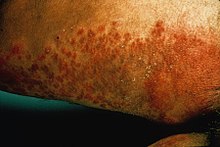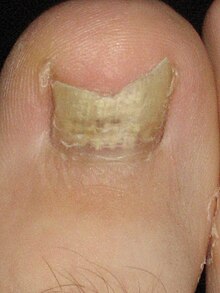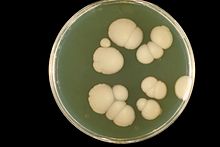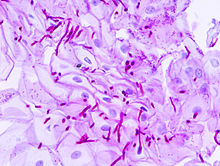Candidiasis: Difference between revisions
→Society and culture: adding "fungal type dysbiosis" to list of proposed candida related conditions by alternative medicine |
Added review article reference to verify that antibiotics can destroy normal flora and make patients susceptible to candida yeast. |
||
| Line 64: | Line 64: | ||
In penile candidiasis, the causes include sexual intercourse with an infected individual, low immunity, antibiotics, and diabetes. Male genital yeast infections are less common, and incidences of infection are only a fraction of those in women; however, yeast infection on the penis from direct contact via sexual intercourse with an infected partner is not uncommon.<ref>{{cite journal |author=David LM, Walzman M, Rajamanoharan S |title=Genital colonisation and infection with candida in heterosexual and homosexual males |journal=Genitourin Med |volume=73 |issue=5 |pages=394–6 |year=1997 |month=October |pmid=9534752 |pmc=1195901}}</ref> |
In penile candidiasis, the causes include sexual intercourse with an infected individual, low immunity, antibiotics, and diabetes. Male genital yeast infections are less common, and incidences of infection are only a fraction of those in women; however, yeast infection on the penis from direct contact via sexual intercourse with an infected partner is not uncommon.<ref>{{cite journal |author=David LM, Walzman M, Rajamanoharan S |title=Genital colonisation and infection with candida in heterosexual and homosexual males |journal=Genitourin Med |volume=73 |issue=5 |pages=394–6 |year=1997 |month=October |pmid=9534752 |pmc=1195901}}</ref> |
||
''Candida'' species are frequently part of the human body's normal oral and intestinal flora. Treatment with [[antibiotics]] can lead to eliminating the yeast's natural competitors for resources, and increase the severity of the condition.{{ |
''Candida'' species are frequently part of the human body's normal oral and intestinal flora. Treatment with [[antibiotics]] can lead to eliminating the yeast's natural competitors for resources, and increase the severity of the condition.<ref>{{cite journal |last1=Bassetti|first1=M|last2=Mikulska|first2=M|last3=Viscoli|first3=C |title=Bench-to-bedside review: therapeutic management of invasive candidiasis in the intensive care unit.|journal=Critical Care |volume=14 |issue=6 |pages=244 |year=2010 |month=December |pmid=21144007 |doi=10.1186/cc9239}}</ref> Higher [[prevalence]] of [[colonization]] of ''C. albicans'' was reported in young individuals with [[tongue]] [[tongue piercing|piercing]], in comparison to unpierced matched individuals.<ref name="Candida">{{cite journal |author= Zadik Yehuda, Burnstein Saar, Derazne Estella, Sandler Vadim, Ianculovici Clariel, Halperin Tamar |title=Colonization of Candida: prevalence among tongue-pierced and non-pierced immunocompetent adults |journal=Oral Dis |volume=16 |issue=2 |pages=172–5 |year=2010 |month=March |pmid=19732353 |doi=10.1111/j.1601-0825.2009.01618.x}}</ref> In the Western Hemisphere, about 75% of females are affected at some time in their lives. |
||
== Diagnosis == |
== Diagnosis == |
||
Revision as of 00:55, 16 February 2013
| Candidiasis | |
|---|---|
| Specialty | Infectious diseases, dermatology |
Candidiasis or thrush is a fungal infection (mycosis) of any of the Candida species (all yeasts), of which Candida albicans is the most common.[1][2] Also commonly referred to as a yeast infection, candidiasis is also technically known as candidosis, moniliasis, and oidiomycosis.[3]
Candidiasis encompasses infections that range from superficial, such as oral thrush and vaginitis, to systemic and potentially life-threatening diseases. Candida infections of the latter category are also referred to as candidemia and are usually confined to severely immunocompromised persons, such as cancer, transplant, and AIDS patients, as well as nontrauma emergency surgery patients.[4]
Superficial infections of skin and mucosal membranes by Candida causing local inflammation and discomfort are common in many human populations.[2][5][6] While clearly attributable to the presence of the opportunistic pathogens of the genus Candida, candidiasis describes a number of different disease syndromes that often differ in their causes and outcomes.[2][5]
Classification
Candidiasis may be divided into the following types:[3]
- Angular cheilitis (perlèche)
- Antibiotic candidiasis (iatrogenic candidiasis)
- Candidal intertrigo
- Candidal paronychia
- Candidal vulvovaginitis (vaginal yeast infection)
- Candidid
- Chronic mucocutaneous candidiasis
- Congenital cutaneous candidiasis
- Diaper candidiasis
- Erosio interdigitalis blastomycetica
- Oral candidiasis (thrush)
- Perianal candidiasis
- Systemic candidiasis
Signs and symptoms


Symptoms of candidiasis vary depending on the area affected.[7] Most candidial infections result in minimal complications such as redness, itching and discomfort, though complications may be severe or even fatal if left untreated in certain populations. In immunocompetent persons, candidiasis is usually a very localized infection of the skin or mucosal membranes, including the oral cavity (thrush), the pharynx or esophagus, the gastrointestinal tract, the urinary bladder, or the genitalia (vagina, penis).[1]
Candidiasis is a very common cause of vaginal irritation, or vaginitis, and can also occur on the male genitals. In immunocompromised patients, Candida infections can affect the esophagus with the potential of becoming systemic, causing a much more serious condition, a fungemia called candidemia.[5][6]
Thrush is commonly seen in infants. It is not considered abnormal in infants unless it lasts longer than a few weeks.[8]
Infection of the vagina or vulva may cause severe itching, burning, soreness, irritation, and a whitish or whitish-gray cottage cheese-like discharge, often with a curd-like appearance. These symptoms are also present in the more common bacterial vaginosis.[9] In a 2002 study published in the Journal of Obstetrics and Gynecology, only 33% of women who were self-treating for a yeast infection actually had a yeast infection, while most had either bacterial vaginosis or a mixed-type infection.[10] Symptoms of infection of the male genitalia include red, patchy sores near the head of the penis or on the foreskin, severe itching, or a burning sensation. Candidiasis of the penis can also have a white discharge, although uncommon.[citation needed]
Causes
Candida yeasts are generally present in healthy humans, particularly on the skin, but their growth is normally limited by the human immune system, by competition of other microorganisms, such as bacteria occupying the same locations in the human body,[11] and in the case of skin, by the relative dryness of the skin, as Candida requires moisture for growth.[12]
C. albicans was isolated from the vaginas of 19% of apparently healthy women, i.e., those who experienced few or no symptoms of infection. External use of detergents or douches or internal disturbances (hormonal or physiological) can perturb the normal vaginal flora, consisting of lactic acid bacteria, such as lactobacilli, and result in an overgrowth of Candida cells, causing symptoms of infection, such as local inflammation.[13] Pregnancy and the use of oral contraceptives have been reported as risk factors.[14] Diabetes mellitus and the use of antibacterial antibiotics are also linked to an increased incidence of yeast infections.[14] Diets high in simple carbohydrates have been found to affect rates of oral candidiases,[15] and hormone replacement therapy and infertility treatments may also be predisposing factors.[16] Wearing wet swimwear for long periods of time is also believed to be a risk factor.[2]
A weakened or undeveloped immune system or metabolic illnesses such as diabetes are significant predisposing factors of candidiasis.[17] Diseases or conditions linked to candidiasis include HIV/AIDS, mononucleosis, cancer treatments, steroids, stress, and nutrient deficiency. Almost 15% of people with weakened immune systems develop a systemic illness caused by Candida species.[18] In extreme cases, these superficial infections of the skin or mucous membranes may enter into the bloodstream and cause systemic Candida infections.
In penile candidiasis, the causes include sexual intercourse with an infected individual, low immunity, antibiotics, and diabetes. Male genital yeast infections are less common, and incidences of infection are only a fraction of those in women; however, yeast infection on the penis from direct contact via sexual intercourse with an infected partner is not uncommon.[19]
Candida species are frequently part of the human body's normal oral and intestinal flora. Treatment with antibiotics can lead to eliminating the yeast's natural competitors for resources, and increase the severity of the condition.[20] Higher prevalence of colonization of C. albicans was reported in young individuals with tongue piercing, in comparison to unpierced matched individuals.[21] In the Western Hemisphere, about 75% of females are affected at some time in their lives.
Diagnosis


Diagnosis of a yeast infection is done either via microscopic examination or culturing.
For identification by light microscopy, a scraping or swab of the affected area is placed on a microscope slide. A single drop of 10% potassium hydroxide (KOH) solution is then added to the specimen. The KOH dissolves the skin cells, but leaves the Candida cells intact, permitting visualization of pseudohyphae and budding yeast cells typical of many Candida species.
For the culturing method, a sterile swab is rubbed on the infected skin surface. The swab is then streaked on a culture medium. The culture is incubated at 37°C for several days, to allow development of yeast or bacterial colonies. The characteristics (such as morphology and colour) of the colonies may allow initial diagnosis of the organism causing disease symptoms.[22]
Treatment
In clinical settings, candidiasis is commonly treated with antimycotics; these antifungal drugs, commonly used to treat candidiasis, are topical clotrimazole, topical nystatin, fluconazole, and topical ketoconazole.
For example, a one-time dose of fluconazole (150-mg tablet taken orally) has been reported as being 90% effective in treating a vaginal yeast infection.[23] This dose is only effective for vaginal yeast infections, and other types of yeast infections may require different dosing. In severe infections, amphotericin B, caspofungin, or voriconazole may be used. Local treatment may include vaginal suppositories or medicated douches. Gentian violet can be used for thrush in breastfeeding babies, but when used in large quantities, it can cause mouth and throat ulcerations, and has been linked to mouth cancer in humans and to cancer in the digestive tract of other animals.[24]
Chlorhexidine gluconate oral rinse is not recommended to treat candidiasis,[25] but is effective as prophylaxis;[26] chlorine dioxide rinse was found to have similar in vitro effectiveness against Candida.[27]
C. albicans can develop resistance to antimycotic drugs.[28] Recurring infections may be treatable with other antifungal drugs, but resistance to these alternative agents may also develop.
History
Descriptions of what sounds like oral thrush go back to the time of Hippocrates circa 460 - 370 BC.[7]
The genus Candida and species C. albicans were described by botanist Christine Marie Berkhout in her doctoral thesis at the University of Utrecht in 1923. Over the years, the classification of the genera and species has evolved. Obsolete names for this genus include Mycotorula and Torulopsis. The species has also been known in the past as Monilia albicans and Oidium albicans. The current classification is nomen conservandum, which means the name is authorized for use by the International Botanical Congress (IBC).[29]
The genus Candida includes about 150 different species; however, only a few are known to cause human infections. C. albicans is the most significant pathogenic species. Other species pathogenic in humans include C. tropicalis, C. glabrata, C. krusei, C. parapsilosis, C. dubliniensis, and C. lusitaniae.
Society and culture
Some alternative medicine proponents postulate a widespread occurrence of systemic candidiasis (or candida hypersensitivity syndrome, yeast allergy, fungal type dysbiosis or gastrointestinal candida overgrowth), a medically unrecognised condition.[30] The view was most widely promoted in a book published by Dr. William Crook[31] that hypothesized a variety of common symptoms such as fatigue, PMS, sexual dysfunction, asthma, psoriasis, digestive and urinary problems, multiple sclerosis, and muscle pain could be caused by subclinical infections of C. albicans.[31] Crook suggested a variety of remedies to treat these symptoms, including dietary modification (commonly referred to as the rainbow diet--eating fresh foods and avoiding foods high in vinegar, sugar, or yeast), prescription antifungals, pau d'arco tea, echinacea tea, and colonic irrigation. With the exception of the few dietary studies in the urinary tract infection section, conventional medicine has not used most of these alternatives, since limited scientific evidence proves either their effectiveness or subclinical systemic candidiasis is a viable diagnosis.[32][33][34][35]
In 1990, alternative health vendor Nature's Way signed an FTC consent agreement not to misrepresent in advertising any self-diagnostic test concerning yeast conditions or to make any unsubstantiated representation concerning any food or supplement's ability to control yeast conditions, with a fine of $30,000 payable to the National Institutes of Health for research in genuine candidiasis.[30]
References
- ^ a b Walsh TJ, Dixon DM (1996). "Deep Mycoses". In Baron S et al. eds. (ed.). Baron's Medical Microbiology (4th ed.). Univ of Texas Medical Branch. ISBN 0-9631172-1-1.
{{cite book}}:|editor=has generic name (help) - ^ a b c d MedlinePlus Encyclopedia: Vaginal yeast infection
- ^ a b James, William D.; Berger, Timothy G.; et al. (2006). Andrews' Diseases of the Skin: clinical Dermatology. Saunders Elsevier. pp. 308–311. ISBN 0-7216-2921-0.
{{cite book}}: Explicit use of et al. in:|author=(help)CS1 maint: multiple names: authors list (link) - ^ Kourkoumpetis T, Manolakaki D, Velmahos G; et al. (2010). "Candida infection and colonization among non-trauma emergency surgery patients". Virulence. 1 (5): 359–66. doi:10.4161/viru.1.5.12795. PMID 21178471.
{{cite journal}}: Explicit use of et al. in:|author=(help)CS1 maint: multiple names: authors list (link) - ^ a b c Fidel PL (2002). "Immunity to Candida". Oral Dis. 8: 69–75. doi:10.1034/j.1601-0825.2002.00015.x. PMID 12164664.
- ^ a b Pappas PG (2006). "Invasive candidiasis". Infect. Dis. Clin. North Am. 20 (3): 485–506. doi:10.1016/j.idc.2006.07.004. PMID 16984866.
- ^ a b Dolin, [edited by] Gerald L. Mandell, John E. Bennett, Raphael (2010). Mandell, Douglas, and Bennett's principles and practice of infectious diseases (7th ed.). Philadelphia, PA: Churchill Livingstone/Elsevier. pp. Chapter 250. ISBN 978-0-443-06839-3.
{{cite book}}:|first=has generic name (help)CS1 maint: multiple names: authors list (link) - ^ "Thrush". 2011. Retrieved 2011-04-08.
- ^ Terri Warren, RN (2010). "Is It a Yeast Infection?". Retrieved 2011-02-23.
- ^ Ferris DG; Nyirjesy P; Sobel JD; Soper D; Pavletic A; Litaker MS (2002). "Over-the-counter antifungal drug misuse associated with patient-diagnosed vulvovaginal candidiasis". Obstetrics and Gynecology. 99 (3): 419–425. doi:10.1016/S0029-7844(01)01759-8. PMID 11864668.
{{cite journal}}: Unknown parameter|month=ignored (help)CS1 maint: multiple names: authors list (link) - ^ Mulley, A. G.; Goroll, A. H. (2006). Primary Care Medicine: office evaluation and management of the adult patient. Philadelphia: Wolters Kluwer Health. pp. 802–3. ISBN 0-7817-7456-X. Retrieved 2008-11-23.
{{cite book}}: CS1 maint: multiple names: authors list (link) - ^ Goehring, Richard V. (2008). Mims' medical microbiology (4th ed. ed.). Philadelphia, PA: Mosby Elsevier. p. 656. ISBN 9780323044752.
{{cite book}}:|edition=has extra text (help) - ^ Mårdh P A, Novikova N, Stukalova E (2003). "Colonisation of extragenital sites by Candida in women with recurrent vulvovaginal candidosis". BJOG. 110 (10): 934–7. doi:10.1111/j.1471-0528.2003.01445.x. PMID 14550364.
{{cite journal}}: Unknown parameter|month=ignored (help)CS1 maint: multiple names: authors list (link) - ^ a b Schiefer HG (1997). "Mycoses of the urogenital tract". Mycoses. 40 (Suppl 2): 33–6. doi:10.1111/j.1439-0507.1997.tb00561.x. PMID 9476502.
- ^ Akpan, A (2002 Aug). "Oral candidiasis". Postgraduate Medical Journal. 78 (922): 455–9. doi:10.1136/pmj.78.922.455. PMC 1742467. PMID 12185216.
{{cite journal}}: Check date values in:|date=(help); Unknown parameter|coauthors=ignored (|author=suggested) (help) - ^ Nwokolo N C, Boag F C (2000). "Chronic vaginal candidiasis. Management in the postmenopausal patient". Drugs Aging. 16 (5): 335–9. doi:10.2165/00002512-200016050-00003. PMID 10917071.
{{cite journal}}: Unknown parameter|month=ignored (help) - ^ Odds FC (1987). "Candida infections: an overview". Crit. Rev. Microbiol. 15 (1): 1–5. doi:10.3109/10408418709104444. PMID 3319417.
- ^ Choo Z.W., Chakravarthi S., Wong S.F., Nagaraja H.S., Thanikachalam P.M., Mak J.W., Radhakrishnan A., Tay A. (2010). "A comparative histopathological study of systemic candidiasis in association with experimentally induced breast cancer". Oncology Letters. 1 (1): 215–222. doi:10.3892/ol_00000039. ISSN 1792-1082. PMC 3436220. PMID 22966285.
{{cite journal}}: CS1 maint: multiple names: authors list (link) - ^ David LM, Walzman M, Rajamanoharan S (1997). "Genital colonisation and infection with candida in heterosexual and homosexual males". Genitourin Med. 73 (5): 394–6. PMC 1195901. PMID 9534752.
{{cite journal}}: Unknown parameter|month=ignored (help)CS1 maint: multiple names: authors list (link) - ^ Bassetti, M; Mikulska, M; Viscoli, C (2010). "Bench-to-bedside review: therapeutic management of invasive candidiasis in the intensive care unit". Critical Care. 14 (6): 244. doi:10.1186/cc9239. PMID 21144007.
{{cite journal}}: Unknown parameter|month=ignored (help)CS1 maint: unflagged free DOI (link) - ^ Zadik Yehuda, Burnstein Saar, Derazne Estella, Sandler Vadim, Ianculovici Clariel, Halperin Tamar (2010). "Colonization of Candida: prevalence among tongue-pierced and non-pierced immunocompetent adults". Oral Dis. 16 (2): 172–5. doi:10.1111/j.1601-0825.2009.01618.x. PMID 19732353.
{{cite journal}}: Unknown parameter|month=ignored (help)CS1 maint: multiple names: authors list (link) - ^ Srikumar Chakravarthi, Nagaraja HS (2010). "A comprehensive review of the occurrence and management of systemic candidiasis as an opportunistic infection". Microbiology Journal. 1 (2): 1–5. ISSN 2153-0696.
- ^ Moosa MY, Sobel JD, Elhalis H, Du W, Akins RA (2004). "Fungicidal Activity of Fluconazole against Candida albicans in a Synthetic Vagina-Simulative Medium". Antimicrob. Agents Chemother. 48 (1): 161–7. doi:10.1128/AAC.48.1.161-167.2004. PMC 310176. PMID 14693534.
{{cite journal}}: CS1 maint: multiple names: authors list (link) - ^ Craigmill A (1991). "Gentian Violet Policy Withdrawn". Cooperative Extension University of California -- Environmental Toxicology Newsletter. 11 (5).
{{cite journal}}: Unknown parameter|month=ignored (help) - ^ "Chlorhexidine Gluconate". Drugs.Com. Retrieved Jan 8, 2011.
- ^ Ferretti GA, Ash RC, Brown AT, Parr MD, Romond EH, Lillich TT (1988). "Control of oral mucositis and candidiasis in marrow transplantation: a prospective, double-blind trial of chlorhexidine digluconate oral rinse". Bone Marrow Transplant. 3 (5): 483–93. PMID 3056555.
{{cite journal}}: Unknown parameter|month=ignored (help)CS1 maint: multiple names: authors list (link) - ^ Uludamar A, Ozkan YK, Kadir T, Ceyhan I (2010). "In vivo efficacy of alkaline peroxide tablets and mouthwashes on Candida albicans in patients with denture stomatitis". J Appl Oral Sci. 18 (3): 291–6. doi:10.1590/S1678-77572010000300017. PMID 20857010.
{{cite journal}}: CS1 maint: multiple names: authors list (link) - ^ Cowen LE, Nantel A, Whiteway MS (2002). "Population genomics of drug resistance in Candida albicans". Proc. Natl. Acad. Sci. U.S.A. 99 (14): 9284–9. doi:10.1073/pnas.102291099. PMC 123132. PMID 12089321.
{{cite journal}}: Unknown parameter|month=ignored (help)CS1 maint: multiple names: authors list (link) - ^ International Code of Botanical Nomenclature. Königstein. 2000. ISBN 3-904144-22-7. Retrieved 2008-11-23.
{{cite book}}: CS1 maint: location missing publisher (link) - ^ a b candidiasis hypersensitivity, National Council Against Health Fraud
- ^ a b Crook, William G. (1986). The yeast connection: a medical breakthrough. New York: Vintage Books. ISBN 0-394-74700-3.
- ^ Weil A (2002-10-25). "Concerned About Candidiasis?". Weil Lifestyle. Retrieved 2008-02-21.
- ^ Barrett S (2005-10-08). "Dubious "Yeast Allergies"". QuackWatch. Retrieved 2008-02-21.
- ^ Katherine Zeratsky. "Candida cleanse: Does it treat candidiasis?". Mayo Clinic. Retrieved 2009-08-09.
- ^ Blonz ER (1986). "Is there an epidemic of chronic candidiasis in our midst?" (PDF). JAMA. 256 (22): 3138–9. doi:10.1001/jama.1986.03380220104032. PMID 3783850.
{{cite journal}}: Unknown parameter|month=ignored (help)
